
Compare the Brains
Who was the so-called Flores hobbit, the three-foot-tall,
18,000-year-old skeleton found in Indonesia in 2003? More
precisely, what was she? Was she a tiny descendant of
Homo erectus? A modern human dwarfed by disease or
genetic defect? Or a new species entirely, as its discoverers
proposed, giving it the name Homo floresiensis?
Paleoanthropologists and other experts are still trying to
answer these and other basic questions about this diminutive
creature (including whether the skeleton belonged to a male
rather than a female, as originally reported). One of the most
highly regarded attempts to determine the hobbit's true
ancestry was undertaken by Dean Falk of Florida State
University and colleagues, who used computers to compare the
size and shape of the hobbit's brain with those of a modern
human, a Homo erectus, and other members of the
great-ape line.* Below, see how the hobbit's brain measured
up—and the novel conclusion that Falk's team
reached.—Peter Tyson & Rachel VanCott
*See Falk, D. et al., "The Brain of LB1,
Homo floresiensis." Science 308, 242-45 (2005).
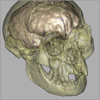

|
|
The study
Dean Falk's team, which included Charles Hildebolt of
the Mallinckrodt Institute of Radiology in St. Louis and
several others, created a virtual endocast, or computer
model, of the hobbit's brain (left). They used CT scans
made of the skull shortly after its discovery. (The
hobbit's skull and other bones are not fossilized and
extremely fragile, making the standard method of making
endocasts—pouring liquid rubber into the
skull—not feasible.) They then compared the
hobbit's virtual endocast with those of a modern woman,
a Homo erectus, a chimpanzee, and a modern
microcephalic (a person with an abnormally small head).
|
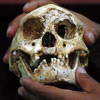

|
|
LB1
The hobbit skeleton is known as LB1, for the cave where
it was found, Liang Bua (Cold Cave). The team's
measurements revealed that LB1's brain was as small as
that of 3.2 million-year-old "Lucy," or about the size
of a chimp's. (See
Who's Who in Human Evolution
for more on our rich evolutionary history.) But LB1 was
associated with charred bones, stone tools, and remains
of Stegodon, a now-extinct dwarf elephant,
suggesting her kind knew how to use fire, cook, and
hunt. How could a tiny hominin with a chimp-sized brain
have had such advanced behaviors? Comparing brains, the
team decided, might help provide an answer. (At left,
LB1's skull.)
|
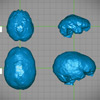

|
|
LB1 and Homo sapiens
After LB1's discovery, some scientists had suggested
that the hobbit was really a modern human, just a small
one. But when Falk's team measured the brains of LB1 and
Homo sapiens, they confirmed what seems obvious
to the eye—the two brains are very differently
shaped. In addition, LB1's body-size-to-brain-size ratio
doesn't match that of a human dwarf. When
H. sapiens bodies shrink, the brain and head stay
relatively large. That's not the case with LB1—her
brain and head are small in proportion to her body.
LB1's brain also bears little resemblance to that of a
human pygmy, the team noted.
|
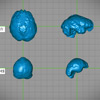

|
|
LB1 and microcephalic Homo sapiens
Was LB1 perhaps a modern human with a pathologically
small brain, one deformed by illness or genetic defect?
No, say Falk and her colleagues. LB1's endocast
indicates her brain fit snugly in her skull, and parts
of her brain are highly convoluted, or intricately
folded. By contrast, microcephalic brains rest loosely
within the braincase and create endocasts that lack
detail, like the one seen here. (Some experts, including
Robert Martin of Chicago's Field Museum, say the team's
sample size of one microcephalic skull was too small,
and they still hold with the modern microcephalic
hypothesis.)
|
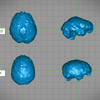

|
|
LB1 and Pan troglodytes
And how did LB1's brain compare to that of a chimpanzee?
While the two brains are about the same size, they
differ dramatically, the team found. LB1's has large
temporal lobes, which in people are linked to hearing
and understanding speech. More significantly, LB1 has
highly convoluted frontal lobes, the region just behind
the forehead that is associated with higher cognition.
Altogether, the findings support the notion of advanced
intelligence in a small package. This flies in the face
of current dogma, which maintains that increased
intelligence only comes through increased brain size.
|
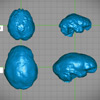

|
|
LB1 and Homo erectus
At a glance, LB1's brain looks much like that of a
shrunken H. erectus, the extinct hominin best
known by the Java Man specimens. Indeed, the two brains
are similar in height and width, and both have a
recognizably low, long lateral profile. To some experts,
such a similar shape strongly suggests an evolutionary
connection. But Falk's team does not believe the hobbit
was a miniaturized descendant of H. erectus. Its
cranial capacity was simply too small to be attributed
to normal dwarfing of H. erectus, they say.
|
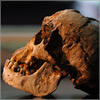

|
|
LB1 a new species?
LB1's similarity to H. erectus, which is thought
to have arrived on Flores by 800,000 years ago, led Falk
and her colleagues to an original conclusion. While it
is possible, they say, that H. floresiensis was a
dwarf species of H. erectus unique to Flores,
they offer an alternative hypothesis.
H. floresiensis and H. erectus, they
suggest, may have shared a common, currently
unidentified ancestor, one that had a small brain and a
small body. About all anyone seems to agree on is that
the hobbit is a fascinating new addition to the puzzle
of human origins and that more work, including DNA
studies, may help clarify things.
|
|


We recommend you visit the
interactive version. The text to the left is provided for printing purposes.
|








